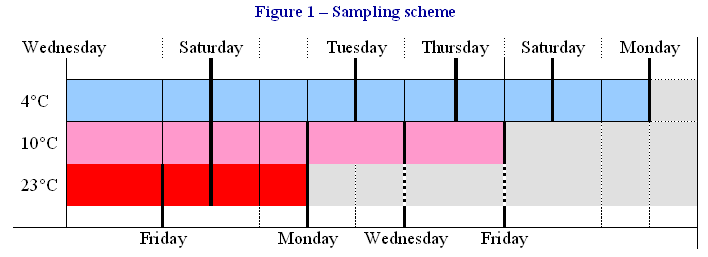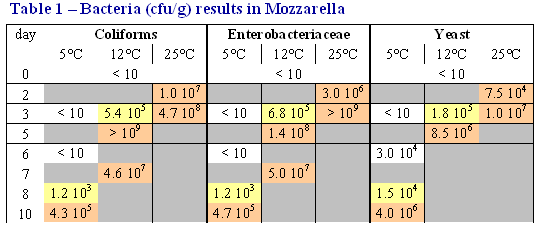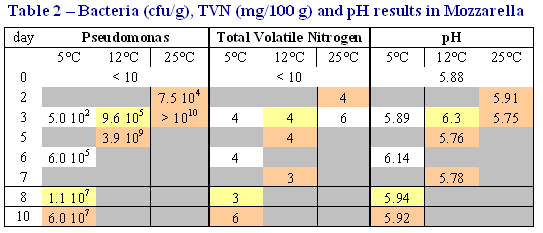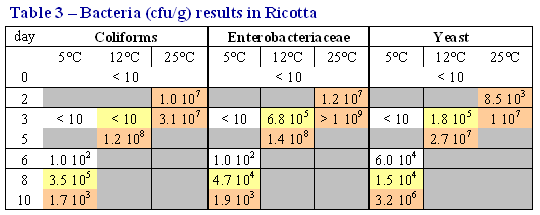Istituto Zooprofilattico Sperimentale dell'Umbria e delle Marche
Webzine Sanità Pubblica Veterinaria: Numero 50-51 Dicembre 2008 [http://www.spvet.it/] ISSN 1592-1581
Documento reperibile all'indirizzo: http://www.spvet.it/arretrati/numero-51/005d.html
Valutazione dei meccanismi di degradazione per predire la durata della conservaziuone in negozio di formaggio freschi - Spoilage mechanisms evaluation to predict the shelf life of fresh cheeses
.
Haouet M. N., Altissimi M. S., Scuota S., Cenci T.
Paper presented at the SLIM (Shelf Life International Meeting) 2008
Abstract. This study was aimed to evaluate the spoilage mechanisms of fresh cheeses at different storage conditions. Mozzarella and Ricotta cheeses were stored at 7, 12 and 25°C and sampled periodically to evaluate sensorial, physical and chemical properties, proteolytic and oxidative reactions and microbial spoilage profile. The bacteria species were further identified. The dominant bacteria resulted some species of Coliforms, especially Citrobacter and Enterobacter, yeast as Rhodotorula and Candida, and Pseudomonas fluorescens causing proteolytic reactions. Limits of acceptability were further evaluated and shelf life was assessed at 8 days a 4°C storage.
Objective of the work.
This work has the aim to evaluate the physical, chemical and microbiological spoilage mechanisms of fresh cheeses at different storage conditions.
Materials and methods.
10 Mozzarella under brine and 10 Ricotta cheeses with the same manufacturing and packaging date, produced and packaged in pots by a Umbria (central Italy) cheese factory, were stored at 5°C, 12°C and 25°C and sampled periodically to evaluate sensorial, physical and nutritional properties, proteolytic and oxidative reactions and microbial spoilage profile. Sampling was performed as shown in figure 1.
Analysis.
pH, moisture content, total volatile nitrogen (TVN), peroxide value, rancidity test (Kreis test), Pseudomonas spp., Coliforms, Enterobacteriaceae, Mould, Yeast, coagulase-positive Staphylococci and Listeria monocytogenes, beside sensorial evaluation.
The detected bacteria species were further identified using Apiweb (bioMérieux Corporate, 2008) and predictive shelf life was achieved following Arrhenius model.
Results.
Only the significant results are shown. Tables 1 and 2: Mozzarella; Tables 3 and 4: Ricotta.
L. monocytogenes and coagulase positive Staphylococci were never detected; Kreis test was at all times negative
|
Shelf life:
8 days, for both Mozzarella and Ricotta stored at 4°C (Ea = 69.14 kj/mole; Q10 = 2.81)
Assessed limits of acceptability:
Mould 102; Yeast 104, Pseudomonas spp. 106 cfu/g; TVN 6 mg/100 g in both Mozzarella and Ricotta.
Coliforms and Enterobacteriaceae 103 cfu/g in Mozzarella, 104 cfu/g in Ricotta. |
Microbial identification.
Enterobacteriaceae were totally represented by Coliforms belonging to Citrobacter freundii, Enterobacter amnigenus, Enterobacter cloacae and Pantoea in Mozzarella and to Citrobacter freundii and Enterobacter cloacae in Ricotta. The yeast were identified as Rhodotorula mucillaginosa, Candida intermedia and Candida farmata in Mozzarella and Rhodotorula glutinis, Rhodotorula mucillaginosa and Rhodotorula minuta in Ricotta. Finally Pseudomonas species were mainly Burkholderia cepacia, Pseudomonas putida and Pseudomonas fluorescens in both Mozzarella and Ricotta cheeses.
Conclusions.
The limiting factors for Mozzarella and Ricotta shelf life are environment and production hygiene, water used during manufacturing, and quality of raw materials
References.
Cabrini, A., Neviani E. 1983. Il genere Pseudomonas causa di sapore amaro e di odore putrido sulla superficie di formaggio Mozzarella. Il Latte 8:90.
Cantoni, C., Iacumin L., Comi G. 2003. Alterazione giallo-arancio di Mozzarella. Ind. Alimentari 42:134–136.
Papaioannou G., Chouliara I., Karatapanis A. E., Kontominas M. G., Savvaidis I. N. 2005. Shelf-life of a Greek whey cheese under modified atmosphere packaging. Int. Dairy Journal, 17(4): 358-364.
Parisi, S. 2003. Evoluzione chimico-fisica e microbiologica nella conservazione di prodotti lattiero-caseari. Ind. Alimentari 42:249–259.
Rondinini, G., Garzaroli C. 1990. Mozzarelle prodotte per acidificazione chimica: Aspetti microbiologici e alterativi. Ind. Alimentari 29:329–334.





